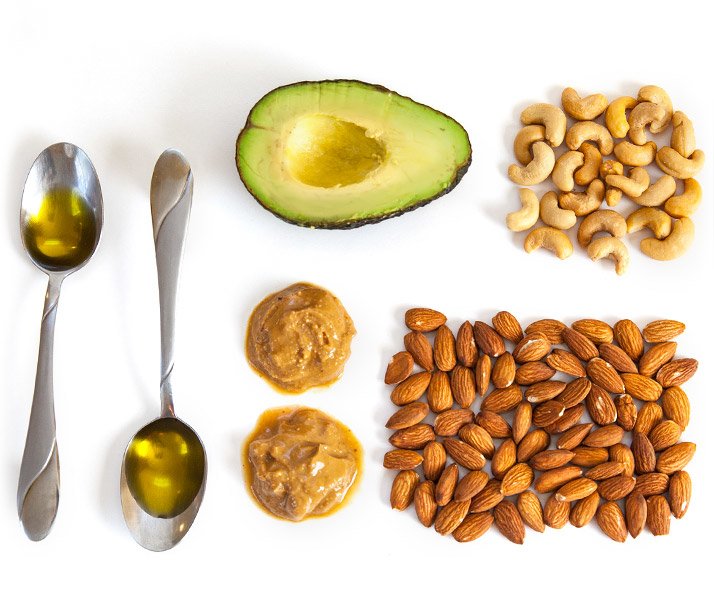Macro- and Micronutrients
All around the nutrition world people talk about eating toward your macros.
I’m sure you heard of the “If it fits your Macros (IIFYM)” but what exactly are
Macros? Macronutrients are simply fats, protein, and carbohydrates. Each of
these macronutrients have a specific job in the body. Macros can be found in
all of our foods; the only difference is how much of each is in each food. For example,
peanut butter has per tablespoon 16 grams of fat, 6 grams of carbohydrates and
8 grams of protein. So roughly 20% of the total calories is coming from
carbohydrates, 26% is coming from protein and 54% is coming from fat. For each
gram of protein and carbs is 4 calories and 9 calories for fat.
Fat
https://www.bodybuilding.com/fun/images/2015/full-macro-pictures-reskin-fat.jpg
“Fat provides the majority of the energy needed
to perform much of the body’s muscular work.” (Sizer and Whitney, 2017, pg.
161) As I mentioned previously 1 gram of fat is 9 calories. Fat is also used to
store excess energy from food. There are 2 types of fats: Saturated and
Unsaturated fats. As I mentioned in my previous blog, Nutrition and Disease, saturated fats such as trans fats are the
bad fats and should be used sparingly or not at all. Especially if the label says,
“partially hydrogenated” which is a dead indicator that there is artificial
trans fats in that particular food. Unsaturated fats like salmon which contain
polyunsaturated fatty acids – Omega 3s, nuts, avocado, olive oils for example
are all good fats.
Protein
http://www.rivertea.com/blog/wp-content/uploads/2014/01/vital_ingredients_artwork-copy1.jpg
Protein has 4 calories per 1 gram. “Protein is essential for
repairing and regenerating body tissues and cells, a healthy functioning immune
system and manufacturing hormones. This wouldn’t be possible without amino
acids, which are found in protein-based foods. In total, there are 20 types of
amino acids, 9 of which are ‘essential’ and can only be found in certain foods.”
(2017) Amino acids are the building blocks of protein and 9 essential amino
acids, which are body cannot make, include Phenylalanine, Valine, Tryptophan,
Threonine, Isoleucine, Methionine, Histidine, Leucine, Lysine. Any easy way to
remember them is with the acronym PVT TIM HiLL.
Dr. Travis Conley explains each of the amino acids functions below:
*Can be found at http://www.ocdoct.com/the-function-of-essential-amino-acids-and-the-human-body/
- Tryptophan: tryptophan is the largest amino acid and is a precursor of serotonin and melatonin, which means that it can regulate mood and sleep.
- Valine: valine is necessary for muscle metabolism and the repair of tissues and can be useful in the treatment of liver and gallbladder disorders.
- Lysine: lysine enables the synthesis of carnitine, which converts fatty acids into energy and also plays an important role in the production of hormones, antibodies and enzymes. Having a deficiency in lysine can lead to niacin deficiency and cause a health condition called pellagra.
- Methionine: this amino acid aids in the production of Sulphur, which is necessary for normal metabolism and it is also essential for the synthesis of hemoglobin and glutathione that fights against free radicals.
- Leucine: Leucine is one of three essential amino acids that increase muscle mass and helps muscle recover after exercise. It also regulates blood sugar and supplies the body with energy. These functions make it invaluable when the body is stressed. Leucine is used clinically to help the body heal, and it also affects brain function and can be used in place of glucose in ‘fasting’ states.
- Isoleucine: isoleucine is important for the regulation of blood sugar.
- Threonine: this amino acid is needed to create other amino acids that aid the production of collagen. It is also important for antibody production.
- Phenylalanine: there are three forms of phenylalanine: D-phenylalanine, L-phenylalanine and DL-phenylalanine. This amino acid is a precursor to catecholamines that regulate the central and peripheral nervous system
Protein can be found in animal meats, beans, leugumes, flax and chia
seeds.
Carbohydrates
http://cdn1.medicalnewstoday.com/content/images/articles/161/161547/people-think-of-bread-pasta-and-rice-when-they-think-of-carbs-but-all-these-foods-are-rich-in-carbs-too.jpg
Carbohydrates get such a bad rap. All you hear is “don’t eat carbs,
carbs are bad, only eat “good” carbs.” Carbohydrates are essential to our body
and brain function. Glucose, our main source of fuel, is broken down from
carbohydrates. Yes, if eaten in excess the body will store the extra sugar as
fat to be used at another time. “Carbohydrates are ideal nutrients to meet your
body’s energy needs, to feed your brain and nervous system, to keep your
digestive system fit, and, within calorie limits, to help fuel physical
activity and keep your body lean.” (Sizer and Whitney, 2017, pg. 114)
There are two types of carbohydrates, complex and simple. Complex
carbs are made of starch and fiber are slow digesting in the body. Simple carbs
are simply sugar and they digest quickly in the body.
Micronutrients
“Micronutrients, as opposed to macronutrients (protein,
carbohydrates and fat), are comprised of vitamins and minerals which are required
in small quantities to ensure normal metabolism, growth and physical well‐being.”
(2017, pg 1) Unfortantely there is no food that has every single vitamin
and mineral we need so it is important to eat a variety of foods that contain each
of these daily. Also a good multivitamin helps!
Vitamins included are vitamin A, provitamin A (Beta‐carotene),
vitamin B1, vitamin B2, vitamin B6, vitamin B12, biotin, vitamin C, vitamin D, vitamin
E, folic acid, vitamin K, niacin and pantothenic acid.
Minerals included are copper, iodine, iron, manganese, selenium and
zinc together with the macro elements calcium, magnesium, potassium and sodium.
References
Sizer, F. & Whitney, E. (2017). Nutrition: Concepts and controversies (14th ed.). Mason, OH: Cengage Learning.What Are Macronutrients & Micronutrients?. (2017). Naturalbalancefoods.com. Retrieved 17 July 2017, from https://www.naturalbalancefoods.com/community/dietary-needs/what-are-macronutrients-micronutrients/
What are Micronutrients. (2017) (pp. 1-2). Retrieved fromh ttps://www.dsm.com/content/dam/dsm/cworld/en_US/documents/what-are-micronutrients.pdf




Comments
Post a Comment
Please visit my website www.AlcineXtreme.com